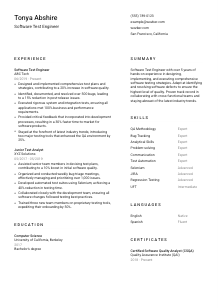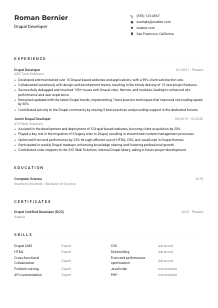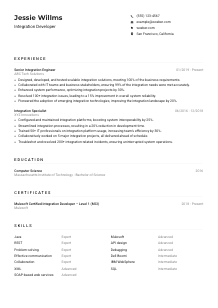Software Test Engineer Resume Example
Breaking code, but your resume isn't running smoothly? Debug your way through this Software Test Engineer resume example, developed with Wozber free resume builder. It showcases how effortlessly you can integrate your testing expertise to match any job spec, ensuring your career path is forever bug-free and accelerated!

How to write a Software Test Engineer resume?
Hello, budding Software Test Engineer! If you're reading this, you're probably gearing up to break into the tech scene or elevate your career in a big way. In the tech domain, especially in a field as critical as software testing, your resume isn't just a document - it's your gateway.
Here, we're going to guide you through tailoring a resume that not only meets but exceeds the expectations of hiring managers, specifically designed for a Software Test Engineer role. With the help of Wozber free resume builder, including exclusive access to ATS-friendly resume templates and an ATS resume scanner, you're about to create a document that lands you that dream interview.
Personal Details
The opening section of your resume is your chance to make a memorable first digital handshake. For a Software Test Engineer, making this section resonant with the job's expectations is your first test. Let's debug the steps to ensure your personal info compiles perfectly with recruiters' expectations.
1. Your Name: The Code Comment That Matters
Think of your name as a crucial code comment that guides the reader through your resume. Ensure it's clearly visible, maybe with a touch of bold or a larger font size. This is the identifier that sets the stage for everything that follows.
2. Positioning Yourself with Precision
Directly under your name, position yourself for success by listing your target role: "Software Test Engineer." This alignment shows the ATS and the hiring manager that you're compiling your career focus directly with the job you're applying for.
3. Contact Points: Links in the Chain
Your phone number and professional email address (yes, firstname.lastname@email.com style) are non-negotiable. These are the links that will connect you with potential employers. Double-check for accuracy; a missed call or an undelivered email is a bug you can't afford.
4. Location: Be Where the Action Is
Since our job demands being located in San Francisco, California, make sure to include this tidbit. It's an immediate compatibility check, showing you're ready and available for office collaborations or onsite duties as required.
5. Digital Footprints: Your Online Repo
Add a link to a professional profile or personal website, such as LinkedIn, especially if it's well-maintained and mirrors the achievements and skills on your resume. Think of it as your public repository showing your contributions and collaborations in the industry.
Takeaway
By carefully crafting this section, you're not just providing contact information; you're also setting a professional tone that aligns with the Software Test Engineer role. It's the critical first impression that paves the way for the details following it. Keep it precise, clean, and oriented towards the job at hand.





Experience
The experience section is where you showcase your debugged and deployed career journey. It's your chance to demonstrate that you're not just familiar with the QA methodology, tools, and processes but that you've also excelled in applying them practically. Let's walk through the process of ensuring your experiences resonate powerfully.
- Designed and implemented comprehensive test plans and strategies, contributing to a 20% increase in software quality.
- Identified, documented, and resolved over 500 bugs, leading to a 15% reduction in post‑release issues.
- Executed rigorous system and integration tests, ensuring all applications met 100% business and performance requirements.
- Provided critical feedback that incorporated into development processes, resulting in a 30% faster time‑to‑market for software products.
- Stayed at the forefront of latest industry trends, introducing two major testing tools that enhanced the QA environment by 25%.
- Assisted senior team members in devising test plans, contributing to a 10% boost in initial software quality.
- Organized and conducted weekly bug triage meetings, effectively managing and prioritizing over 1,000 issues.
- Developed automated test suites using Selenium, achieving a 40% reduction in testing time.
- Collaborated closely with the development team, ensuring all software changes followed testing best practices.
- Trained three new team members on proprietary testing tools, expediting their onboarding by 50%.
1. Dissecting the Requirements
Begin by examining the provided job description closely. Highlight experiences that directly respond to requirements such as working with automation tools like Selenium or UFT, and knowledge of QA methodologies. This assures you're speaking the same language as your potential employer.
2. Chronology Meets Strategy
List your roles starting from the most recent. For each position, include your title, the company name, and the period of employment. It's like writing a test script that must execute in the right order for successful outcomes.
3. Assert Your Achievements
For each role, articulate your accomplishments that directly mirror the responsibilities and qualifications cited in the job description. Use active language and keywords from the job ad. Instead of "responsible for," say "designed and implemented comprehensive test plans" as in the resume example.
4. Quantify Your Success
Every tester knows the value of measurable results. So, quantify your achievements wherever possible. Managed to reduce post-release issues by 15%? That's a compelling statistic that conveys your impact.
5. Relevancy Overload
Your journey as an office ping-pong champ, while impressive, won't make the cut here. Focus solely on experiences that demonstrate your prowess in software testing. Aligning each bullet point with the job's demands makes your resume a well-compiled code, free of unnecessary lines.
Takeaway
These steps allow you to present a version of your professional journey that doesn't just list your roles but showcases a series of successful deployments in your career. Each entry is an assertion of your capability, ready to pass the hiring manager's review with zero exceptions.
Education
While the skills and experiences sections may do the heavy lifting, don't overlook the importance of the Education section. For a Software Test Engineer, this section underlines your foundational knowledge in computer science, acting as proof of your understanding of the theoretical underpinnings of your field.
1. Highlighting the Degree
Directly align your degree with the job requirements. If the job calls for a "Bachelor's degree in Computer Science," precisely that should feature in your resume. It's the keyword match that can make the ATS (and eventually the hiring manager) see you as a strong candidate.
2. The Structure of Success
Keep the format clear and straightforward with the field of study, degree, institution name, and graduation date. This section is like a well-documented code; it should be easy for others to understand at a glance.
3. Degree Specification
For roles as specific as a Software Test Engineer, the closer your degree matches the job requirements, the better. If you've majored in computer science, detail any pertinent focus areas or projects that relate directly to software testing or QA methodologies.
4. Coursework Counts
Especially relevant for fresh graduates or those with less hands-on experience, mentioning specific courses like 'Software Quality Assurance' or 'Automated Testing' can serve as proxies for direct experience and show your preparedness for the role.
5. Certifications and Extras
Beyond your degree, include any relevant certifications or coursework like the "Certified Software Quality Analyst (CSQA)" that reflect ongoing education and a commitment to staying current in your field. This demonstrates your dedication to professional growth.
Takeaway
A well-crafted education section gives confidence to hiring managers about your solid base in computer science and your dedication to mastering your craft. It's not just about having the degree; it's about showcasing its relevance to the role you're pursuing.
Certificates
In the evolving landscape of technology, certifications can be your badges of continuous learning and expertise. For a Software Test Engineer, they display an additional layer of commitment to your craft. Let's get into how to present these effectively.
1. Relevant Reconnaissance
Start with recognizing which certifications align best with the Software Test Engineer role. While the job description might not call for specific certificates, having a "Certified Software Quality Analyst (CSQA)" badge directly echoes your commitment to quality and expertise.
2. Prioritize and Present
Only showcase certifications that add value to your candidacy for the specific role you're applying for. It's about quality, not quantity. Highlight the ones that demonstrate your proficiency in testing tools, methodologies, or processes relevant to the position.
3. Date It
Include acquisition dates for recent certifications to emphasize your ongoing commitment to staying up-to-date in the field. For certifications without expiration dates, such as CSQA, indicating the acquisition year suffices to convey its currency.
4. Be Committed to Current
The field of software testing is rapidly evolving, so your commitment to continuing education through certifications is a strong signal of your dedication to keeping your skills sharp and relevant.
Takeaway
Certificates on your resume act as signals of your dedication to professional growth and your capability to meet and exceed the standards of the industry. They bolster your resume by providing solid proof of your specialized skills and knowledge.
Skills
Your skills section should read like a well-commented script, highlighting the tools, methodologies, and soft skills you command within the realm of software testing. Let's optimize this section to speak directly to the essence of a Software Test Engineer's role.
1. Parsing the Job Description
Start by dissecting the job listing for specific skills mentioned, such as "experience with automation tools such as Selenium or UFT" and "strong knowledge of QA methodology, tools, and processes." These keywords are your guide.
2. Strategic Listing
Align your listed skills with those mentioned in the job description. Prioritize them based on the job's demands, ensuring the first few skills directly match the essential requirements.
3. Trim the Fat
While it might be tempting to list every skill you possess, focus instead on the most relevant ones. An ATS, and later a hiring manager, will appreciate a succinct list that aligns perfectly with the job's needs.
Takeaway
Effectively showcasing your skills tells the hiring manager that your toolbox is not only full but also organized and ready to tackle the challenges specific to the Software Test Engineer role. Remember, your skills section is a promise of the value you'll bring to the team.
Languages
In the field of software testing, where accuracy and clarity in communication are paramount, your ability to articulate issues and collaborate globally can set you apart. Let's navigate through aligning your language skills with the job's requirements.
1. Parsing the Listing
Initially, look for any language requirements or preferences in the job description. In our case, "Proficient English speaking and listening skills necessary" was explicitly mentioned.
2. Highlight Required Languages
Start with the languages that are directly mentioned in the job listing. In this scenario, ensure that English is listed at the top with the proficiency level clearly indicated.
3. Showcase Additional Languages
Even if not explicitly required for the role, additional languages you speak fluently can be an asset, especially in global companies or teams. They reflect your ability to adapt and communicate in diverse environments.
4. Honest Proficiency
Accuracy in depicting your language proficiency is key. From "Native" to "Basic," use clear terms that genuinely reflect your comfort and capability level. This honesty guarantees the hiring team's expectations are in line with reality.
5. The Global Tester
For roles with a broader geographical scope or in multi-cultural settings, the ability to communicate in multiple languages can be a standout skill. This isn't just about being able to chat in another language; it's about breaking down barriers and ensuring clarity in a connected world.
Takeaway
Your language skills can greatly contribute to your appeal as a Software Test Engineer candidate. They're a testament to your ability to function and thrive in a global workspace, ensuring the software you test is accessible and understandable across borders.
Summary
An effective summary invites the hiring manager to delve deeper into your resume. It's your professional pull request, asking them to merge your experience and skills with what they need for a Software Test Engineer. Here's how to craft a summary that gets approved on the first pass.
1. Grasp the Job's Core
Revisit the job listing to absorb the essence of what they're looking for in a Software Test Engineer. This understanding will serve as the backbone for your summary.
2. Lead with Your Identity
Begin with a statement about your profession and level of experience, positioning yourself confidently as a Software Test Engineer with the right mix of expertise and achievements.
3. Reflect Required Skills and Achievements
Highlight pivotal skills and accomplishments that align with the job requirements. For instance, pointing out your success in "identifying and resolving software defects to ensure the highest level of quality" directly matches one of the key responsibilities.
4. Precision and Clarity
Keep your summary crisp and to the point. Utilize 3-5 powerful lines that capture your professional essence and directly address why you're an excellent fit for the Software Test Engineer role.
Takeaway
Your summary is the prelude to your professional narrative. It's not just about who you are; it's about how you align perfectly with what the role requires. Craft it with care, and let it reflect your confidence and competence as a Software Test Engineer, beckoning the hiring manager to explore the depth of your experience and skills.
Launching Your Software Test Engineer Journey
With these insights and steps, you're ready to craft a Software Test Engineer resume that goes beyond just ticking the boxes. It's about creating a document that speaks directly to hiring managers, telling them you're the candidate they've been searching for. Leverage the power of Wozber free resume builder, including ATS-friendly resume templates and ATS optimization techniques to ensure your resume stands out.
Remember, your resume is more than just a sheet of paper; it's a code that unlocks new opportunities. Write it well, test it thoroughly, and get ready to embark on an exciting new chapter in your career!

- Bachelor's degree in Computer Science, Engineering, or equivalent experience.
- Minimum of 3 years of experience in software testing or development.
- Strong knowledge of QA methodology, tools, and processes.
- Experience with automation tools such as Selenium or UFT.
- Excellent analytical, problem-solving, and communication skills.
- Proficient English speaking and listening skills necessary.
- Must be located in San Francisco, California.
- Design and implement test plans, test cases, and test scripts to ensure high software quality.
- Identify, record, and track bugs to closure while collaborating with development teams.
- Perform system and integration testing, ensuring applications meet business and performance requirements.
- Provide feedback and recommendations to improve software quality and development processes.
- Stay updated with the latest industry trends, best practices, and tools to continuously enhance the QA environment.















